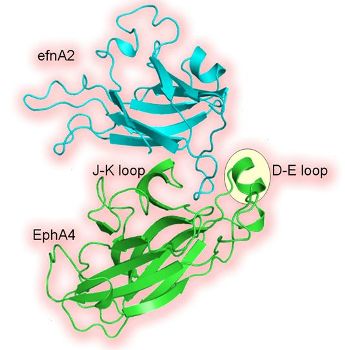Nerves and blood vessels grow to the right places because they receive instructions to keep them on the correct path. These instructions come from pairs of molecules: receptors and ligands on the surface of different cells. When a matched pair makes contact in a specific ‘handshake’ it directs the cell carrying the receptor right or left, just like SatNav. If we understand what different handshakes look like, we can design drugs that to strengthen them – to help nerve regeneration, or stop them - possibly preventing cancer cells spreading. To see the handshake in detail we need a synchrotron. Using Diamond we found (see below) that the ligand (Ephrin, blue) presents a loop grasped by the receptor (Eph), a beautifully specific interaction that defines the cell navigation signal.
|
|  |
| Eph receptor | Ephrin ligand |
Tom Bowden, Radu Aricescu, Jo Nettleship, Christian Siebold, Weixian Lu,Nahid Rahman, Karl Harlos, Jon Grimes, Stephen Graham, Ray Owens, Yvonne Jones & Dave Stuart Structural Biology, Nuffield Department of Medicine, Oxford University. Funded by CRUK and MRC.
Diamond Light Source is the UK's national synchrotron science facility, located at the Harwell Science and Innovation Campus in Oxfordshire.
Copyright © 2022 Diamond Light Source
Diamond Light Source Ltd
Diamond House
Harwell Science & Innovation Campus
Didcot
Oxfordshire
OX11 0DE
Diamond Light Source® and the Diamond logo are registered trademarks of Diamond Light Source Ltd
Registered in England and Wales at Diamond House, Harwell Science and Innovation Campus, Didcot, Oxfordshire, OX11 0DE, United Kingdom. Company number: 4375679. VAT number: 287 461 957. Economic Operators Registration and Identification (EORI) number: GB287461957003.